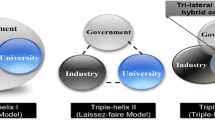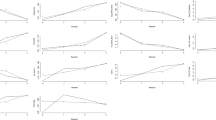Abstract
The Triple Helix model of university-industry-government relations allows us to use mutual information among geographical, sectorial, and size distribution of firms to measure synergy at various geographical scales in a nation. In this paper we decompose the synergy in Triple Helix relations and analyze the decomposition at the county level. We use micro-level data for all Norwegian firms from 2002 to 2014. This provides new and more detailed insight into the factors explaining the previously reported variation in synergy at county level in Norway. Furthermore, we analyze the county and city level distributions of all national as well as USPTO granted patents with at least one Norwegian inventor. Co-inventor networks for Norwegian USPTO patents are visualized using Google maps. The counties with technology-dominated synergies and strong knowledge institutions have a higher level of international co-inventor networks. Sectorial and geographical networks characterize the oil and gas dominated county, Rogaland. In contrast the knowledge institution dominated county of Sør-Trøndelag has broader networks both with regard to sectors and geography. In the small industry dominated county of Møre og Romsdal with high synergy, the lack of international co-inventor network is striking. This might be interpreted as a sign of industrial lock-in. The use of both firm level and patent data together give a broader and more precise picture of the innovation systems under study. The use of both national and international patent data also broadens the picture of the innovation activity of the nation.













Similar content being viewed by others
Notes
Nomenclature générale des activités économiques dans les Communautés Européennes (General Industrial Classification of Economic Activities within the European Communities).
Nomenclature des unités territoriales statistiques.
References
Abramson, N.: Information Theory and Coding. McGraw Hill, New York (1963)
Almeida, P., Kogut, B.: Localization of knowledge and the mobility of engineers in regional networks. Manag. Sci. 45(7), 905–917 (1999)
Asheim, B.T., Coenen, L.: Knowledge bases and regional innovation systems: comparing Nordic clusters. Res. Policy 34, 1173–1190 (2005)
Asheim, B.T., Isaksen, A.: Location, agglomeration and innovation: towards regional innovation systems in Norway? Eur. Plan. Stud. 5(3), 299–330 (1997)
Balconi, M., Breschi, S., Lissioni, F.: Networks of inventors and the role of academia: an exploration of Italian patent data. Res. Policy 33, 127–145 (2004)
Benner, M., Sandstrøm, U.: Institutionalizing the Triple Helix: research funding and norms in the academic system. Res. Policy 29(2), 291–301 (2000)
Bettencourt, L.M.A., Lobo, J., Strumsky, D.: Invention in the city: increasing returns to patenting as a scaling function of metropolitan size. Res. Policy 36, 107–120 (2007)
Breschi, S., Lissioni, F.: Mobility of skilled workers and co-invention networks: an anatomy of localized knowledge flows. J. Econ. Geogr. 1–30 (2009)
Carlino, G.A., Chatterjee, S., Hunt, R.M.: Urban density and the rate of invention. J. Urban Econ. 61, 389–419 (2007)
Choi, S., Yang, J.S.W., Park, H.W.: Quantifying the Triple Helix relationship in scientific research: statistical analysis on the dividing pattern between developed and developing countries. Qual. Quant. 49, 1381–1396 (2015)
de Nooy, W., Mrvar, A., Batagelj, V.: Exploratory Social Network Analysis with Pajek. Cambridge University Press, Cambridge (2011)
Etzkowitz, H., Leydesdorff, L.: The Triple Helix—University-industry-government relations: a laboratory for knowledge-based economic development. EASST Rev. 14, 14–19 (1995)
Etzkowitz, H., Leydesdorff, L.: The dynamics of innovation: from National Systems and ‘Mode 2’ to a Triple Helix of university-industry-government relations. Res. Policy 29(2), 109–123 (2000)
Eurostat 2012. http://ec.europa.eu/eurostat/statistics-explained/index.php/R_%26_D_expenditure (2012). 10 Apr 2016
EU 2014. http://ec.europa.eu/growth/industry/innovation/facts-figures/scoreboards/index_en.htm (2014)
Fitjar, R.D., Rodríguez-Pose, A.: Firm collaboration and modes of innovation in Norway. Res. Policy 42(1), 128–138 (2013)
Furman, J.L., Porter, M.E., Stern, S.: The determinants of national innovation capacity. Res. Policy 31, 899–934 (2002)
Grillitsch, M., Nilsson, M.: Innovation in peripheral regions: do collaborations compensate for lack of local knowledge spillovers? Ann. Reg. Sci. 54, 299–321 (2015)
Gulbrandsen, M., Smeby, J.C.: Industry funding and university professors’ research performance. Res. Policy 34, 932–950 (2005)
Ivanova, I., Strand, Ø., Leydesdorff, L.: Synergy cycles in the Norwegian innovation system: the relation between synergy and cycle values (in preparation)
Ivanova, I., Leydesdorff, L.: Rotational symmetry and the transformation of innovation systems in a Triple Helix of university-industry-government relations. Technol. Forecast. Soc. Change 86, 143–156 (2014)
Isaksen, A.: Innovation dynamics of global competitive regional clusters: the case of the Norwegian centers of expertise. Reg. Stud. 43(9), 1155–1166 (2009)
Isaksen, A., Onsager, K.: Regions, networks and innovative performance: the case of knowledge-intensive industries in Norway. Euro. Urban Reg. Stud. 17(3), 227–243 (2010)
Isaksen, A., Karlsen, J.: Can small regions construct regional advantages? The case of four Norwegian regions. Euro. Urban Reg. Stud. 20(2), 243–257 (2012)
Jaffe, A.B., Tratjienberg, M.: Patents, Citations, and Innovations: A Window on the Knowledge Economy. MIT Press, Cambridge (2002)
Jensen, M.B., Johnson, B., Lorenz, E., Lundvall, B.Å.: Forms of knowledge and modes of innovation. Res. Policy 36, 680–693 (2007)
Jung, K., Park, H.W.: Interactions among Networks in the age of “Big Data”: social, knowledge, and triple-helix networks. J. Contemp. East. Asia 13(1), 1–4 (2014)
Khan, G.F., Park, H.W.: Triple Helix and innovation in Asia using scientometrics, webometrics, and informetrics. Scientometrics 90, 1–7 (2012)
Kim, J.K.: A hyperlink and semantic network analysis of the Triple Helix (University-Government-Industry): the interorganizationel communication structure of nanotechnology. J. Comput. Med. Commun. 17, 152–170 (2012)
Kwon, K.-S.: Are scientific capacity and industrial funding critical for universities’ knowledge transfer activities?—a case study of South Korea. J. Contemp. East. Asia 10(1), 15–23 (2011)
Kwon, K.-S., Martin, B.R.: Synergy or separation mode: the relationship between the academic research and the knowledge-transfer activities of Korean academics. Scientometrics 90, 177–200 (2012)
Lengyel, B., Leydesdorff, L.: Regional innovation systems in Hungary: the failing synergy at the national level. Reg. Stud. 45(5), 677–693 (2011)
Leydesdorff, L., Bornmann, L.: Mapping (USPTO) patent data using overlays to Google Maps. J. Am. Soc. Inf. Sci. Technol. 63(7), 1442–1458 (2012)
Leydesdorff, L., Dolfsma, W., van der Panne, G.: Measuring the knowledge base of an economy in terms of triple-helix relations among ‘technology, organization, and territory’. Res. Policy 35(2), 181–199 (2006)
Leydesdorff, L., Ivanova, I.: Mutual redundancies in inter-human communication systems: steps towards a calculus of processing meaning. J. Am. Soc. Inf. Sci. Technol. 65(2), 386–399 (2014)
Leydesdorff, L., Meyer, M.: Triple Helix indicators of knowledge-based innovation systems: introduction to the special issue. Res. Policy 35(10), 1441–1449 (2006)
Leydesdorff, L., Park, H.W.: Can synergy in triple-helix relations be quantified? a review of the development of the triple-helix indicator. Triple Helix J. Univ. Ind. Gov. Innov. Entrep. 1(4), 1–19 (2014)
Leydesdorff, L., Persson, O.: Mapping the geography of science: distribution patterns and networks of relations among cities and institutes. J. Am. Soc. Inf. Sci. Technol. 61(8), 1622–1634 (2010)
Leydesdorff, L., Strand, Ø.: The Swedish system of innovation: regional synergies in a knowledge-based economy. J. Am. Soc. Inf. Sci. Technol. 64(9), 1890–1902 (2013)
Meyer, M., Grant, K., Morlacchi, P., Weckowska, D.: Triple Helix indicators as an emergent area of enquiry: a bibliometrical perspective. Scientometrics 99, 151–174 (2014)
Narula, R.: Innovation systems and ‘inertia’ in R&D location: Norwegian firms and the role of systemic lock-in. Res. Policy 31, 795–816 (2002)
Park, H.W.: An interview with Loet Leydesdorff: the past, present, and future of the Triple Helix in the age of big data. Scientometrics 99, 199–202 (2014)
Ranga, M., Etzkowitz, H.: Triple Helix systems: an analytical framework for innovation policy and practice in the knowledge society. Ind. High. Educ. 27(3), 237–262 (2013)
Research Concil Of Norway.: (RCN) Science and Technology Indicators for Norway 2014. 978-82-12-03364-1 (PDF). http://www.forskningsradet.no/servlet/Satellite?blobcol = urldata&blobheader = application%2Fpdf&blobheadername1 = Content-Disposition%3A&blobheadervalue1 =+attachment%3B + filename%3D%2220141Komplettrapportendelig201410.pdf%22&blobkey = id&blobtable = MungoBlobs&blobwhere = 1274505537435&ssbinary = true. Accessed by 10 Oct 2014
Reis, J., Tereso, J.D.: Map of Norwegian counties. http://no.wikipedia.org/wiki/Norges_fylker#mediaviewer/File:Norway_counties.svg. Accessed by 10 Oct 2014
Reve, T., Sasson, A.: Et kunnskapsbasert Norge (Norwegian)/A knowledge-based Norway. Universitetsforlaget, Oslo (2012)
Robin, S., Schubert, T.: Cooperation with public research institutioins and success in innovation: evidence from France and Germany. Res. Policy 42, 149–166 (2013)
Rodríguez-Pose, A.: Do institutions matter in regional development. Reg. Stud. 47(7), 1034–1047 (2013)
Shelton, R.D., Leydesdorff, L.: Publish or patent: bibliometric evidence for empirical trade-offs in national funding strategies. J. Am. Soc. Inf. Sci. Technol. 63(3), 498–511 (2012)
Simmie, J.: Innovation and urban regions as national and international nodes for the transfer and sharing of knowledge. Reg. Stud. 37(6&7), 607–620 (2003)
Stek, P.E., van Geenhuizen, M.S.: Measuring the dynamics of an innovation system using patent data: a case study of South Korea, 2001–2010. Qual. Quant. 49, 1325–1343 (2015)
Storper, M.: The Regional World: Territoriel Development in a Global Economy. Guilford Press, New York (1997)
Strand, Ø., Leydesdorff, L.: Where is synergy indicated in the Norwegian innovation system? Triple-Helix relations among technology, organization and geography. Technol. Forecast. Soc. Change 80, 471–484 (2013)
Strand, Ø.: Industrial rights as quality indicators of the regional innovation systems in Norway. In: Amdam, J., Helgesen, Ø., Sæther, K.W. (eds.) Det mangfaldige kvalitetsomgrepet, Fjordantologien 2013, pp. 335–356. Forlag1, Ålesund (2014)
Acknowledgments
This paper was presented at the DISC conference in Daegu, South Korea in December 2014 and we acknowledge comments and feedback from several colleagues in the discussion. We thank two anonymous reviewers and the Editor for insightful comments and suggestions for improvements of the manuscript. Inga Ivanova acknowledges support of the Basic Research Program at the National Research University Higher School of Economics (NRU HSE) and the Global Competitiveness Program of the Government of the Russian Federation.
Author information
Authors and Affiliations
Corresponding author
Appendix
Appendix
See Table 3.
Rights and permissions
About this article
Cite this article
Strand, Ø., Ivanova, I. & Leydesdorff, L. Decomposing the Triple-Helix synergy into the regional innovation systems of Norway: firm data and patent networks. Qual Quant 51, 963–988 (2017). https://doi.org/10.1007/s11135-016-0344-z
Published:
Issue Date:
DOI: https://doi.org/10.1007/s11135-016-0344-z




